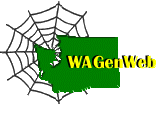Pioneer life in the Benton Co. WA area
Death Struck the Young/Early Funerals Recalled
By BURTON 0. LUM
Tri-City Pioneer
Tri-City Herald, Sunday, 11 February 1962
Having personally attended all burials that occurred in Kennewick from 1889 to 1900, I will give a short and authoritative report on each. The first burial was Charley Gray, the five—year old son of Capt. Al Gray and his wife Carrie. Capt. Gray was the captain of the ferry boat Frederick K. Billings that transferred the trains across the Columbia before the Kennewick N.P.R.R. bridge was built.
Capt. Gray erected quite a large picket fence around his son’s grave and donated the fenced grounds as a burial place for the entire community. This first burial was held about 73 years ago. The cause of death was thought to be spinal meningitis.
The second burial was the infant child of Charles Aune and wife Gina, from infantile diseases, about 71 years ago.
The third burial was the second son of Mr. and Mrs. Rice. I am at this time unable to recall their given name. The cause was a bowel obstruction. The date of this burial was about 66 years ago.
The fourth burial was that of Clarence Martin, the oldest son of William Martin, Sr., and his wife, Ella. The cause of Clarence’s death was tuberculosis. This burial was about 64 years ago.
The original land that Capt. Gray donated for burial purposes, was located about a half mile upstream from the Kennewick portal of the N.P.R.R. bridge and a quarter of a mile back from the river bank, near Capt. Gray’s windmill tower. These burials were quite vividly impressed upon my mind with the exception of the Rice boy’s funeral.
Father Charles E. Lum would always make the coffin and Mother, Almyra A. Lum, covered and trimmed it with black calico. Father and mother donated everything to each grief-stricken family. Father helped dig the grave and prepared the grave boxes to receive the coffins. There was neither priest nor parson in this community in those days. Father had to substitute at the funerals. He offered a prayer. He gave a short talk at the funeral in which he gave a resume of the deceased life. Mother sang several appropriate songs. Father assisted the pioneer pallbearers in lowering the coffin into the grave box using the reins out of a four-horse set. The grave box cover was securely fastened. Father repeated “Ashes to ashes and dust to dust,” and dropped some dirt on the grave box and prayed. After which everyone sang “Blest Be the Tie That Binds.” Then the friends of the deceased relatives led them sorrowfully away to their conveyances and took them home. Other friends stayed at the graveside and back filled the grave with stones and gravel to keep the coyotes and other animals from molesting the grave.
Burials, except in real cold weather, were held quite shortly after death had been completely determined. This was necessary because there were no methods then available to embalm the corpse. After the fenced burial ground had been donated by Capt. Gray, the pioneers who had relatives buried in this burial ground would bring wild flowers when they were in bloom and decorate the graves of their departed loved ones. The soil of this tract was extremely sandy and barren. There was touching pathos in the rusty tomato can that stood alone, empty and forlorn, at the head of a grave. This can’s once shining interior bad been filled with crystal water that sustained the wild flowers, which loving and remembering hands had placed therein. The heat of the hot dry atmosphere had evaporated the water. The wild flowers perished and were blown away. The shiny Interior of the can became emptv and rusty. A blinking sand lizard slithered around on the rusty rim.
Return to Index of Burton Lum Articles

